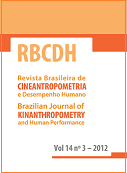Can neuromuscular fatigue threshold bedetermined by short and non-exhaustive bouts?
DOI:
https://doi.org/10.1590/1980-0037.2012v14n3p254Abstract
The present study determined the neuromuscular fatigue threshold (NFT) using four different time-periods of analysis of the electromyographic signal and compared these estimations with critical power (CP). Fifteen healthy young men (73.6 ± 5.1 kg, 177.8 ± 7.0 cm, 23.4 ± 5.2 years) performed 3-4 different severe constant workload trials until exhaustion on a cycle ergometer with simultaneous SEMG signals acquisition. The obtained data permitted NFT estimation with four different periods of analysis as follows: initial 30s (T30), 1min (T1), 2min (T2) and total time (TT), as well as CP. T30 and T1 were significantly higher than TT and CP and, T2 and TT did not differ between each other, and both were significantly higher than CP. In addition, TT was significantly correlated to CP (0.72; P < 0.05) and to T2 (0.58; P < 0.05). We conclude that NFT overestimates CP, independent of the time-period analysis used for its determination.



